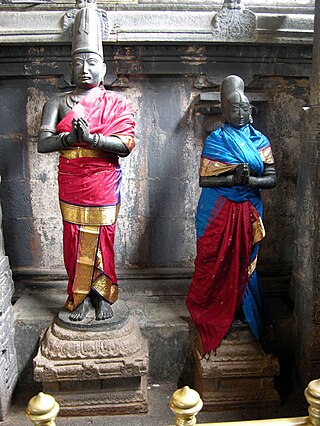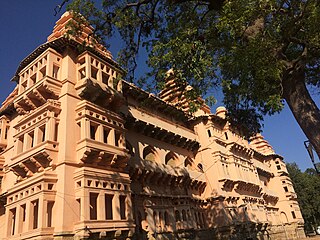This article needs additional citations for verification .(December 2013) |
| |||||
| Centuries: | |||||
|---|---|---|---|---|---|
| Decades: | |||||
| See also: | List of years in India Timeline of Indian history | ||||
Events from the year 1565 in India.
This article needs additional citations for verification .(December 2013) |
| |||||
| Centuries: | |||||
|---|---|---|---|---|---|
| Decades: | |||||
| See also: | List of years in India Timeline of Indian history | ||||
Events from the year 1565 in India.

Krishnadevaraya was an emperor of the Vijayanagara Empire reigning from 1509 to 1529. He was the third monarch of the Tuluva dynasty, and is considered to be one of the greatest rulers in Indian history. He ruled the largest empire in India after the fall of the Islamic Delhi Sultanate. Presiding over the empire at its zenith, he is regarded as an icon by many Indians. Krishnadevaraya earned the titles Andhra Bhoja, Karnatakaratna Simhasanadeeshwara, Yavana Rajya Pratistapanacharya, Kannada Rajya Rama Ramana, Gaubrahmana Pratipalaka and Mooru Rayara Ganda. He became the dominant ruler of the peninsula by defeating the sultans of Bijapur, Golconda, the Bahmani Sultanate and the Gajapatis of Odisha, and was one of the most powerful Hindu rulers in India.

Achyuta Deva Raya was an Emperor of Vijayanagara who succeeded his older brother, the Emperor Krishna Deva Raya after the latter's death in 1529 CE.

Rama Raya was a statesman of the Vijayanagara Empire, the son-in-law of Emperor Krishna Deva Raya and the progenitor of the Aravidu dynasty of Vijayanagara Empire, the fourth and last dynasty of the empire. As a regent, he was the de facto ruler of the empire from 1542 to 1565, although legally the emperor during this period was Sadasiva Raya, who was merely a puppet ruler. Rama Raya was killed at the Battle of Talikota, after which the Vijayanagara Empire got fragmented into several semi-independent principalities paying only nominal allegiance to the empire.
The Battle of Talikota, also known as that of Rakkasagi–Tangadagi, was a watershed battle fought between the Vijayanagara Empire and an alliance of the Deccan sultanates. The battle resulted in the defeat of Rama Raya which led to the eventual collapse of the polity and reconfigured Deccan politics.
Vira Narasimha Raya became the Emperor of Vijayanagara after the death of his predecessor Narasimha Raya II. He was the older half-brother of Krishnadevaraya.
The Aravidu Dynasty was the fourth and last Hindu dynasty of Vijayanagara Empire in South India. Its founder was Tirumala Deva Raya, whose brother Rama Raya had been the masterful regent of the last ruler of the previous dynasty. Rama Raya's death at the Battle of Talikota in 1565 led to the subsequent destruction of Vijayanagar by the combined forces of the Muslim states of the Deccan. The Aravidu family claimed to be Kshatriyas and were based in Andhra region. They claimed to belong to the Atreya gotra and traced their lineage to the Eastern Chalukya king Rajaraja Narendra.
Sadasiva Raya was an Emperor of Vijayanagara who reigned from 1542 to 1570 CE. When the Vijayanagara Emperor Achyuta Raya died in 1542 CE, his son, Venkata I, succeeded him. However, Venkata I was assasinated six months later. Sadasiva Raya, who was the nephew of Achyuta Raya, became the new Emperor in accordance with the Aliya succession laws which was prevalent among the Tuluvas. Sadasiva Raya, along with his Prime Minister Rama Raya, restored the Vijayanagara empire's power, which had diminished after the reign of Krishna Deva Raya. The strategy was to play the Turko-Persian Sultanates in the Deccan against each other by first allying with one and then another.
Tirumala Deva Raya was the first Crowned King of the Vijayanagara Empire from the Aravidu Dynasty. He was the younger brother of Rama Raya and husband of Vengalamba making him the son-in-law of Krishna Deva Raya. Following the Battle of Talikota, he rescued the last Tuluva king, Sadasiva Raya, and relocated the capital to Penukonda. After Sadasiva's death in 1570, he crowned himself monarch of Vijayanagara. He was succeeded by his son, Sriranga I.
Rama Deva Raya ascended the throne after a gruesome war in 1617 as the King of Vijayanagara Empire. In 1614 his father, Sriranga II the preceding King and his family were gruesomely murdered by rival factions headed by Jagga Raya, who was one of their kins. Rama Deva himself was smuggled out of the prison by Yachama Naidu, a faithful commander and the viceroy of earlier king Venkata II.
Sriranga Deva Raya was the eldest son of Tirumala Deva Raya and Vengalmba. He was a king of Vijayanagara empire based at Penukonda. He carried the restoration of the Vijayanagara empire, but his reign was marred with repeated attacks and loss of territories from his Muslim neighbours.
Venkatapati Raya was the younger brother of Sriranga Deva Raya and the ruler of Vijayanagara Empire with bases in Penukonda, Chandragiri and Vellore. His reign of three decades saw a revival of the strength and prosperity of the empire. He dealt successfully with the Deccan sultans of Bijapur and Golkonda, the internal disorders, promoting economic revival in the country. He brought rebelling Nayakas of Tamil Nadu and parts of present-day Andhra Pradesh under control.

Venkata III was the grandson of Aliya Rama Raya. Venkata III belonged to a Telugu family and became the King of the Vijayanagara Empire from 1632 to 1642. His brothers-in-law were Damarla Venkatappa Nayaka and Damarla Ayyappa Nayaka, both sons of Damarla Chennapa Nayakadu.
Pemmasani Ramalinga Nayudu was an army commander of a Vijayanagara military unit. An inscription dated to 1544 CE, which was found in Tallaproddatu, states that Pemmasani Ramalinga enjoyed the nayankara of the village. Phillip B. Wagoner who analysed 17th century Telugu text Rayavachakamu noted that it is not known whether Ramalinga Nayudu served Krishnadeva Raya or some later ruler.
Events from the year 1569 in India.

The Vijayanagara military supported the Vijayanagara Empire in particular with regard to the empire's long-lasting rivalry with the Bahmani Sultanate. Besides a large standing army, the Vijayanagara rulers also maintained a powerful navy. This helped make the Vijayanagara empire the most centralised polity ever to have emerged in South India. However, a major portion of the imperial income was committed to military purposes, straining the economy.

Chandragiri Fort is an historical fort located in the Chandragiri suburb of Tirupati. It is situated in Tirupati district of Andhra Pradesh, India. It is mostly associated with the Vijayanagara Emperors. In 1460 A.D. Odra Gajapati Kapilendra Dev captured the Chandragiri Fort.
Venkata I was an Emperor of Vijayanagara from the Tuluva Dynasty. He was the son of Emperor Achyuta Deva Raya, whom he succeeded in 1542 CE.
Chamaraja Wodeyar III was fifth raja of the Kingdom of Mysore and the last one to rule as feudal king under the Vijayanagara Empire. He reigned after his father's demise in 1513 until his death in 1553.

Tirumala Devi was the senior wife and chief queen of Emperor Krishnadevaraya, who is considered to be the greatest ruler of the Vijayanagara Empire. She was also the most honoured wife of Krishnadevaraya, and the mother of his heir-apparent, Prince Tirumala, who died in his childhood.
Anegundi Raj is one of the most important estate in the then Bellary district, British Raj, present in the Gangavathi taluk, Koppal district in the Indian state of Karnataka. After the downfall of the glorious Vijayanagara Empire at Chandragiri, the last emperor Sri Ranga III named Rama Raya recovered some part of his ancestral dominion and retained Anegundi, part of Chitaldurgam and part of Harpanahalli as a jagir from the Mohammedan government.